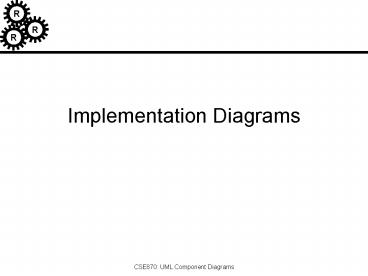Implementation Diagrams - PowerPoint PPT Presentation
Title:
Implementation Diagrams
Description:
Implementation Diagrams – PowerPoint PPT presentation
Number of Views:42
Avg rating:3.0/5.0
Title: Implementation Diagrams
1
Implementation Diagrams
2
Implementation Diagrams
- Both are structural diagrams
- Component Diagrams
- set of components and their relationships
- Illustrate static implementation view
- Component maps to one or more classes,
interfaces, or collaborations - Deployment Diagrams
- Set of nodes and their relationships
- Illustrate static deployment view of
architecture - Node typically encloses one or more components
3
Package
- General purpose mechanism for organizing elements
into groups - Can group classes or components.
4
Component Diagram
- Classes
- Interfaces
- Dependency, generalization, association, and
realization relationships - Special kind of class diagram focusing on
systems components.
5
Interfaces
- Definition
- Collection of operation signatures and/or
attribute defns - Defines a cohesive set of behaviors
- Realized by
- Implemented by classes and components
- Implement operations/attributes defined by
interface - Relationships
- A class can implement 0 or more interfaces
- An interface can be implemented by 1 or more
classes - Notation
- Lollipop
- Dashed arrow
Ambler, 2002-2005
6
Sample interfaces
Ambler, 2002-2005
7
Example Component Diagram
Ambler, 2002-2005
8
Component Diagram
executable
find.html
page
Index.html
Comp2.dll
Comp1.dll
library
9
Common Uses
- Model source code
- model configuration mgmt
- Model executable releases
- Release is relatively complete and consistent set
of artifacts delivered to user - Release focuses on parts necessary to deliver
running system - Component Diagram visualizes, specifies, and
documents the decisions about the physical parts
that define the software.
10
Common Uses (contd)
- Model Physical databases
- database is concrete realization of schema
- schemas offer an API to persistent information
- model of physical dbases represents storage of
that information in tables of a relational dbase
or pages of an OO dbase. - Component Diagram can represent this kind of
physical database - Model Adaptable systems
- can model static aspects of adaptable systems
- can model dynamic aspects (in conjunction with
behavioral models)
11
Modeling Source Code
- (Forward/Reverse Eng) identify set of source
code files of interest - model as components stereotyped as files
- Larger systems use packages to show groups of
source code files - Model compilation dependencies among files
12
Modeling Source Code Example
- 5 source code files
- signal.h (header)
- used by 2 other files (signal.cpp, interp.cpp)
- interp.cpp has compilation dependency to header
file (irq.h) - device.cpp compilation dependency to interp.cpp
ltltparentgtgt
ltltparentgtgt
Signal.cpp
Interp.cpp
Irq.h
Device.cpp
13
Component Diagram Guidelines
- Use Descriptive Names for Architectural
Components - Use Environment-Specific Naming Conventions for
Detailed Design Components - Apply Textual Stereotypes to Components
Consistently - Avoid Modeling Data and User Interface Components
- Interfaces
- Prefer Lollipop Notation To Indicate Realization
of Interfaces By Components - Prefer the Left-Hand Side of A Component for
Interface Lollipops - Show Only Relevant Interfaces
- Dependencies and Inheritance
- Model Dependencies From Left To Right
- Place Child Components Below Parent Components
- Components Should Only Depend on Interfaces
- Avoid Modeling Compilation Dependencies
14
Common Stereotypes
Stereotype Indicates ltltapplicationgtgt A
front-end of your system, such as the
collection of HTML pages and ASP/JSPs that
work with them for a browser-based system or the
collection of screens and controller classes
for a GUI-based system. ltltdatabasegtgt A
hierarchical, relational, object-relational,
network, or object-oriented database. ltltdocumentgtgt
A document. A UML standard stereotype. ltltexecuta
blegtgt A software component that can be executed
on a node. A UML standard stereotype. ltltfilegtgt A
data file. A UML standard stereotype. ltltinfrastru
cturegtgt A technical component within your system
such as a persistence service or an audit
logger. ltltlibrarygtgt An object or function
library. A UML standard stereotype. ltltsource
codegtgt A source code file, such as a .java file
or a .cpp file. ltlttablegtgt A data table within a
database. A UML standard stereotype ltltweb
servicegtgt One or more web services. ltltXML
DTDgtgt An XML DTD.
15
Deployment Diagrams
16
Deployment Diagram
- Shows the configuration of
- run time processing nodes and
- the components that live on them
- Graphically collection of vertices and arcs
17
Contents
- Deployment diagrams contain
- Nodes
- Dependency and association relationships
- may also contain components, each of which must
live on some node.
18
A Deployment Diagram
Modem bank
node
Internet
connection
ltltnetworkgtgt local network
19
Modeling Client-Server Architecture
- Identify nodes that represent systems client and
server processors - Highlight those devices that are essential to the
behavior - E.g. special devices (credit card readers, badge
readers, special display devices) - Use stereotyping to visually distinguish
20
Client-Server System
- Human resource system
- 2 pkgs client, server
- Client 2 nodes
- console and kiosk
- stereotyped, distinguishable
- Server 2 nodes
- caching server and server
- Multiplicities are used
client
console
kiosk
server
4..
2..
ltltprocessorgtgt
ltltprocessorgtgt
Caching server
server
21
Guidelines for Deployment Diagrams
- General Ambler 2002-2005
- Indicate Software Components on Project-Specific
Diagrams - Focus on Nodes and Communication Associations on
Enterprise-Level Diagrams - Nodes and Components
- Name Nodes With Descriptive Terms
- Model Only Vital Software Components
- Apply Consistent Stereotypes to Components
- Apply Visual Stereotypes to Nodes
- Dependencies and Communication Associations
- Indicate Communication Protocols Via Stereotypes
- Model Only Critical Dependencies Between
Components
22
Sample Communication Links

